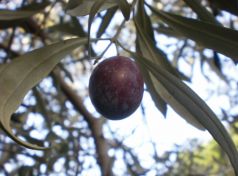Greek Olives
The world’s most famous olive is, of course, Greek: the almond-shaped, brownish-black, tight-skinned Kalamata. There are dozens of table olive varieties in Greece, most with regional provenance. All olives start out green and turn black or dark brown as they ripen. Certain Greek olives are harvested green, others, such as the Kalamata, are left to mature a bit longer and harvested as they turn color, and still others are left to mature fully on the tree, turning leathery and wrinkled in the process. Green Greek olives are often stuffed or seasoned with wild fennel, or lemon and garlic or hot pepper flakes. Kalamata and other dark olives are stored in either vinegar or olive oil. Wrinkled black or plump brown olives, which come mainly from Thassos and Halkidiki respectively, are salt cured. Greek olives make an excellent snack and addition to many foods, from salads to sauces. In recent years, some Greek food producers have experimented with sweetened olives, in the form of jams and preserves.



